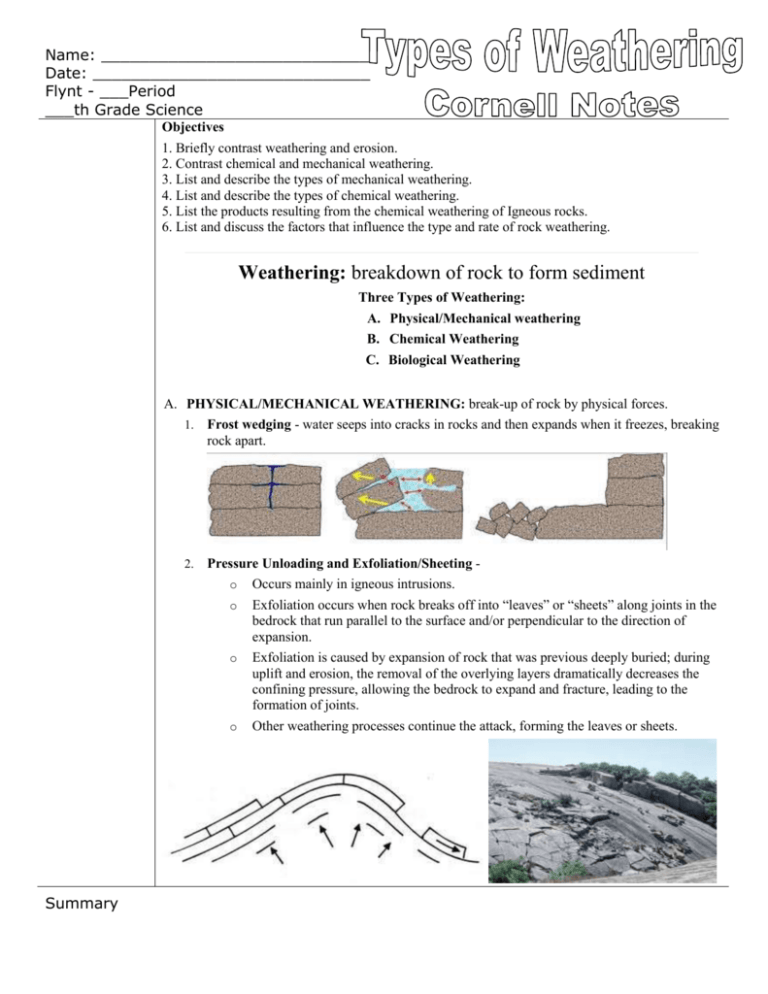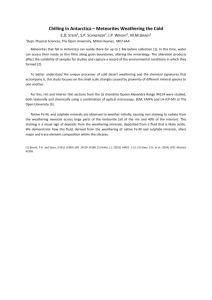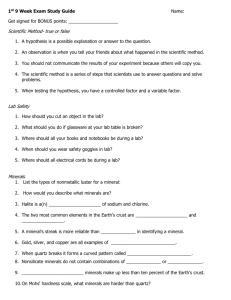B. Chemical Weathering
advertisement

Name: ____________________________ Date: _____________________________ Flynt - ___Period ___th Grade Science Objectives 1. Briefly contrast weathering and erosion. 2. Contrast chemical and mechanical weathering. 3. List and describe the types of mechanical weathering. 4. List and describe the types of chemical weathering. 5. List the products resulting from the chemical weathering of Igneous rocks. 6. List and discuss the factors that influence the type and rate of rock weathering. Weathering: breakdown of rock to form sediment Three Types of Weathering: A. Physical/Mechanical weathering B. Chemical Weathering C. Biological Weathering A. PHYSICAL/MECHANICAL WEATHERING: break-up of rock by physical forces. 1. Frost wedging - water seeps into cracks in rocks and then expands when it freezes, breaking rock apart. 2. Summary Pressure Unloading and Exfoliation/Sheeting o Occurs mainly in igneous intrusions. o Exfoliation occurs when rock breaks off into “leaves” or “sheets” along joints in the bedrock that run parallel to the surface and/or perpendicular to the direction of expansion. o Exfoliation is caused by expansion of rock that was previous deeply buried; during uplift and erosion, the removal of the overlying layers dramatically decreases the confining pressure, allowing the bedrock to expand and fracture, leading to the formation of joints. o Other weathering processes continue the attack, forming the leaves or sheets. 3. 4. Thermal Expansion o Repeated daily heating and cooling of rock, especially exposed outcrops and boulders. o Believed to be exacerbated (worsened) by the presence of water. o Heat causes expansion; cooling causes contraction. o When expansion/contraction occurs at different rates in different regions of the rock/boulder (such as surface versus interior) this causes stress that leads to jointing and exfoliation; this sometimes results in a boulder or cliff that appears to peel like the layers of an onion. o When expansion/contraction of different MINERALS within the rock occurs at different rates, this leads to disintegration of the rock. Abrasion- physical weathering typically accomplished by sediment particles rubbing against and breaking other rocks and/or sediments into smaller pieces; physical grinding of rock fragments by other rock fragments. o Sediments causing the abrasive force are typically carries by a fluid current such as wind or water. The Wave is a famous geologic feature found in the Coyote Buttes near the border of Utah and Arizona, USA. The Wave was formed mainly by the scouring and abrasion of sediments carried by wind. The rock layers being eroded are actually 190-million-year-old cross-bedded sand dunes turned to rock (the Navajo Sandstone, which is Jurassic in age). As sand weathers from the Navajo sandstone, it is picked up and swirled by the wind, creating the abrasive pieces that loosen even more sand. The multi-colored hues of the layers are due to presence of iron oxides. Summary B. CHEMICAL WEATHERING: Occurs when rocks chemically reacts with water (ocean water, ground water, precipitation, etc.), atmospheric gasses, and/or other solutions resulting in a chemical change in the mineral composition of the rock. 1. Dissolution/Solution Weathering o o There are several common minerals dissolve in water, most notably: halite calcite Limestone and marble contain calcite and are soluble in weakly acidic water. o Marble tombstones and carvings are particularly susceptible to chemical weathering by dissolution. o Caves and caverns form when limestone and dolostone bedrock are chemically weathered by slightly acidic groundwater. Speleothems are cave formations made of calcite (called travertine) that form when dissolved calcium carbonate precipitates out of groundwater, typically drop by drop. Photo taken in an above-ground cemetery in New Orleans. Note that the urn and upper ledges of the monument are heavily weathered, while the inscriptions, which are somewhat sheltered from (acid) rain, remain legible. Stalactites - hang from ceiling (hold on tight!) Stalagmites – “grow” from the ground up Karst topography includes all topographical features and landforms associated with the dissolution of limestone/dolostone bedrock. Karst topography includes caves/caverns, sinkholes, disappearing streams, springs, etc. Summary 2. Oxidation: Oxygen combines with iron-bearing silicate minerals causing "rusting" o o 3. Common minerals affected by oxidation: olivine pyroxene amphibole biotite Iron oxides are produced: limonite hematite goethite o Iron oxides are red, orange, or brown in color o Mafic rocks such as basalt (which may contain olivine, pyroxene, or amphibole) weather by oxidation to an orange color o "Georgia Red Clay" derives its color from the oxidation of iron bearing minerals Hydrolysis o Silicate minerals weather by hydrolysis to form CLAY. o Feldspar alters to clay (kaolinite) plus dissolved materials (ions) o Feldspars are stable at high temperatures and pressures (but not at the temperatures and pressures of the Earth's surface) o Clays are stable under conditions at the Earth's surface Summary Kaolin mine, central Georgia o Feldspars and clays are similar in composition. o Feldspar readily alters to clay when in contact with acid and water. o Iron-bearing silicate minerals weather to form clays by hydrolysis (in addition to oxidizing to form iron oxides) Bowen’s Reaction Series/Goldich Stability Series o The Goldich Stability Series describes the tendency for silicate minerals (minerals with silica in their chemical formula) to weather (break down). o Minerals which form at high temperatures and pressures (deeper in the earth) are not very stable at the Earth’s surface; these minerals weather quickly because they are farther from their "zone of stability", or the conditions under which they formed. o Minerals which form at lower temperatures and pressures (near the Earth’s surface) are more stable near the Earth’s surface and therefore weather more slowly. o The order of mineral stability in the weathering environment (the surface) from LEAST stable to MOST stable is the same order as Bowen's Reaction Series. Bowen’s Reaction Series organizes common, rock-forming igneous and metamorphic minerals from deepest forming (highest temp at the top) to shallowest forming (lowest temp at the bottom). The Goldich Stability Series lists these same minerals from least stable (most likely to undergo weathering at the Earth’s surface) to most stable (least likely to undergo weathering at the Earth’s surface). Notice that olivine is most likely to weather into other minerals, while quartz is least likely to weather into other minerals at the Earth’s surface. What happens when granite is weathered? First, unweathered granite contains these minerals: Summary o Na Plagioclase feldspar o K feldspar o Quartz o Lesser amounts of biotite, amphibole, or muscovite The feldspars will undergo hydrolysis to form kaolinite (clay) and Na+ and K+ ions. The Na+ and K+ ions will be removed through leaching by groundwater. The biotite and/or amphibole will undergo hydrolysis to form clay, and oxidation to form iron oxides. The quartz (and muscovite, if present) will remain as residual minerals because they are very resistant to weathering. Weathered rock is called saprolite. Weathered rock fragments are one of the constituents of soil (the abiotic part of soil). What happens after this? o Quartz grains may be eroded, becoming sediment. The quartz in granite is sandsized; it becomes quartz sand. The quartz sand will ultimately be transported to the sea (bed load), where it accumulates to form beaches (near-shore marine deposits). o Clays will ultimately be eroded and washed out to sea. Clay is fine-grained and remains suspended in the water column (suspended load); it may be deposited in quiet water (deeper water farther from the shore). o Dissolved ions will be transported by rivers to the sea (dissolved load), and will become part of the salts in the sea. C. BIOLOGICAL/ORGANIC WEATHERING: the breakdown of rock into sediment and/or sediment into soil due to the direct action of organisms or as the result of biological processes. Organic weathering can be classified as mechanical weathering, chemical weathering, or both. Examples of Biological Weathering: 1. Physical penetration and growth of roots. 2. Digging/burrowing activities of animals (bioturbation). 3. Chemical reaction between rock minerals and various acids released by lichens growing on rocks. 4. Chemical reactions between minerals and biofilms left by microbes, worms, snails, etc. as they burrow through rocks. Close-up of lichen growing on pink granite from Texas. Summary Summary








